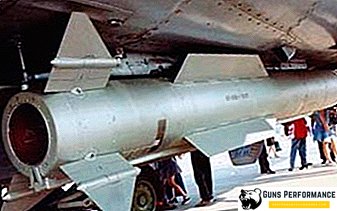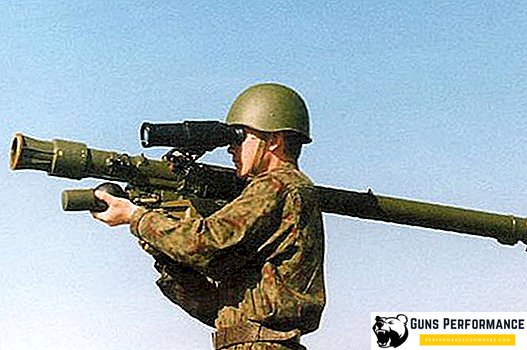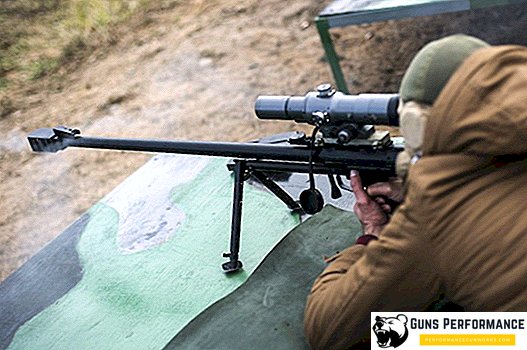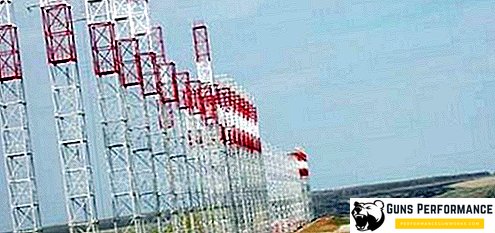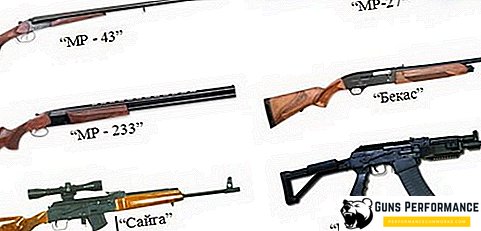The RPG-7 is a truly unique and legendary weapon, not very inferior in its popularity to the famous AK-47. The RPG-7 is an anti-tank grenade launcher, an effective means of fighting against tanks and other armored vehicles. He allows the infantryman not to feel defenseless in the face of an armored mechanical monster.

The RPG-7 was adopted by the Soviet Army back in 1961, and despite such a solid age, it still remains in service. This grenade launcher participated in countless conflicts and wars on all continents. And the emergence of new, more advanced ammunition makes the RPG-7 dangerous, even for modern tanks and armored vehicles.
RPG-7 is the favorite weapon of the partisans and revolutionaries. It was used by Vietcong fighters in the Vietnamese jungle and Afghan mujahideen against the Soviet troops. A photograph of a rebel or partisan with an RPG pipe on his shoulder is almost as natural as a Kalashnikov assault rifle in his hands. By its simplicity, cheapness and efficiency, this weapon is not inferior to the Kalashnikov assault rifle.

How many instances of the RPG-7 today is fighting in different countries of the world - no one knows. Experts believe that only "legal" (that is, issued by the manufacturer or under its license) copies produced more than a million units. How many grenade launchers were released without a license or were stolen from military depots after the collapse of the USSR - no one can say.
History of the RPG-7
Experts call the forerunner of this weapon a German grenade launcher (or rather, grenade launchers, for there were several of them) Panzerfaust, created by the Germans in the second half of World War II and which caused a lot of trouble to tank crews. Anti-tank remedy turned out very cheap and effective. At the same time it was so simple that even a teenager could hit a tank. Some experts point to some similarities between RPGs and American bazookas, with which the US Army armed anti-tank crews in Europe.

In the middle of the last century, anti-tank hand grenades, rifle grenade launchers, an RPG-2 hand-held grenade launcher and recoilless guns were used by the Soviet Army in service with the tanks. Several enterprises were engaged in the development of grenade launchers at once, but for all of them this weapon was not the mainstream, and therefore the products were not of the highest quality.
In 1958, the Moscow GSKB-47 was appointed as the main enterprise for the production of anti-tank grenade launchers (in the future, the famous "Basalt"). The RPG-7 hand-held anti-tank grenade launcher was developed under the leadership of Vladimir Vasilyevich Degtyarev, the son of the famous Soviet gunsmith.

From 1948 until that time, the RPG-2 grenade launcher was in service with the Red Army, the technical characteristics of which did not suit the military. In particular, the firing range of the RPG-2 was only 50-80 meters. An RPG-4 grenade launcher was created with a higher speed of a grenade, but the firing range did not increase significantly. This grenade launcher went with a series, it was also produced under license in China and in Vietnam. At the time, the Soviet Army had already received the Bumblebee ATGM capable of hitting a tank at a distance of between six and two thousand meters, but at a distance closer than six hundred meters there was nothing to hit the enemy’s armored vehicles.
The designers were tasked with “teaching” a hand-held grenade launcher to hit enemy tanks in melee combat, and they coped with this task. A new PG-7V grenade was developed, on which a jet engine was installed, which made it possible to significantly increase the firing range. The new grenade launcher was named the RPG-7.

The RPG-7 was specially designed for use against tanks, self-propelled artillery installations and other types of enemy armored vehicles, as well as against manpower, both in open areas and in shelters. With the advent of the RPG-7 and PG-7V grenades, the infantry received a simple and effective weapon for various purposes.
The design of the RPG-7 was so simple and successful that, despite the emergence of more advanced versions of the same grenade launcher, the RPG-7 is still at war in different parts of the world.
Design RPG-7
The device grenade launcher RPG-7 is extremely simple. It consists of a barrel (essentially a pipe), with an optical and mechanical sight mounted on it, a firing mechanism and a striker. It can be said that this is a smooth-bore gun of a recoilless type. According to the instructions, it is necessary to shoot the RPG-7 from the shoulder, so in the middle part of the grenade launcher there is a heat-insulating casing. On the back of the grenade launcher is a nozzle for more effective discharge of powder gases when fired.

RGP-7 has two handles: the front comes in conjunction with the firing mechanism, and the back is made for a more comfortable holding of the weapon. When fired, the striker strikes the primer, which, in turn, ignites a small powder charge, which pushes the grenade out of the barrel and gives it a rotational motion.
After the grenade launcher leaves the pipe, stabilizers of the grenade are opened and the charge of its main jet engine ignites. It should be noted that the jet engine enters at a safe distance from the grenade thrower. After taking off from the barrel, a grenade fuse is cocked.

The rocket engine of the grenade accelerates it at the initial stage of the trajectory to a speed of 300 m / s, after its burning, the grenade flies by inertia. If she doesn’t encounter any obstacle on her way, then after a distance of 1000 meters, the self-destructor is triggered and the grenade explodes.
Since the grenade launcher was designed according to the recoilless scheme, it has practically no recoil. Powder gases go back through the nozzle of the weapon, and this balances the force of recoil when fired.

At first, the RPG-7 grenade launcher had a PGO-7 optical sight with a range scale, as well as marks for lateral corrections. However, in the mid-60s, the grenade launcher was equipped with a more sophisticated PGO-7V sight. Models equipped with these sights, received the designation RPG-7B.
Technical characteristics of the RPG-7
The grenade launcher has several modifications, it is produced in several countries of the world, but its main technical characteristics are unchanged:
| Combat performance | RPG-7 |
| Caliber | 40 mm |
| Weight | 6.3 kg |
| Length | 950 mm |
| Maximum shot range | 700 m |
| Mass of grenades | 2 - 4.5 kg |
| Initial grenade speed | 112 - 145 m / s |
Video on the RPG-7
Grenades for RPG-7
Any weapon, no matter how perfect it is, is only a means to use ammunition. The same is true of the RPG-7. The success of this weapon is connected with the creation of the PG-7V grenade, which made it possible to seriously increase the firing range. On the device grenades should stay in detail.

The grenade (or shot) consists of their body with an explosive and a cumulative funnel, as well as a pipe in which the grenade jet engine and powder charges for them are located. In the pipe are primer and powder charge, pushing a shot from the barrel of a grenade launcher. On the pipe there are four stabilizers, which, after their departure from the trunk, open up and stabilize the grenade in flight. At the front edge of the pipe are the nozzles of a jet engine grenade, which accelerates it in flight.
On the front edge of the case there is a fuse that triggers when a grenade strikes an obstacle. PG-7V is a cumulative grenade designed to combat the enemy’s armored vehicles. When a grenade is blown up, a thin cumulative jet is formed, it burns through the armor and creates a huge temperature and excessive pressure in the reserve space.

Grenades for the RPG-7 grenade launcher were improved following the improvement of armor protection. Currently known several types of shots for a grenade launcher. In addition to grenades with a cumulative warhead, there are fragmentation and thermobaric ammunition.
| Year of issue | Index | Warhead | Caliber | Armor penetration |
| 1961 | PG-7V / 7P1 | cumulative | 85 mm | 260 mm |
| 1972 | PG-7VS | cumulative | 72 mm | 400 mm |
| 1988 | PG-7VR "Summary | tandem cumulative | 65/105 mm | DZ + 650 mm |
| 1988 | TBG-7V "Tannin" | thermobaric | 105 mm | manpower damage radius: 10 m |
| 1998 | OG-7V "Fragment" | Frag | 49 mm | 150 m² |
Modifications of the RPG-7
- RPG-7 - the first version of the famous grenade launcher
- RPG-7V - with improved sight
- RPG-7D - landing option
- RPG-7N / RPG-7DN - landing variant, equipped with night sight
- RPG-7V1 - with an optical sight
- RPG-7V2 - with universal sighting device UP-7V
- The RPG-7D3 is a modern version of 2001.
RPG-7 and its variants are produced under license in various countries: Romania, Bulgaria, Iraq, Iran, China, Sudan and many others. Even the US is releasing its version of the RPG-7. On the American version installed seven Picatinny rail, which allows you to install anything on the grenade launcher.

Combat use RPG-7
For the first time, the RPG-7 took an active part in the hostilities in Vietnam. His debut was very successful. The sighting range of the RPG-7 is 330 meters. During the Chechen company, the tactics of attack by Chechen separatists against federal troops was based on the use of grenade launchers. To date, due to improved protection of tanks (multi-layered armor, dynamic protection, active protection), the effectiveness of hand-held grenade launchers has slightly decreased, especially for older types of grenades. For example, in Iraq, American and British tanks carried up to 15 hits of grenades without breaking through the armor.

One of the design features of the RPG-7 is the defeat of the jet stream of all that is behind the shooter, so according to the instructions, the fighter must make sure that there are no people behind his back. However, this is a minus characteristic of any types of recoilless guns.


